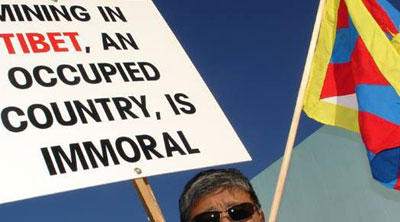WEDNESDAY, 17 APRIL 2013
Gabriel Lafitte on how China's lust for gold is spoiling Tibet
"While greed and fear, trust and mistrust have an influence over the price of many assets, like houses and stocks, those ultimately produce some income, which provides a fundamental base from which markets can infer prices. Gold, on the other hand, neither toils nor spins, but just sits there looking pretty. That means gold is far more volatile, with emotion and short-term supply and demand driving sharp swings in prices. Like someone who spends too much time in bars late at night, gold has the unlikeliest things happening to it over and over again."
So says Reuters columnist James Saft, trying to explain the latest wild gyrations in the price of gold. The Asian Argument at the core of Spoiling Tibet, due out in September, is that China's lust for gold is so great, this is the driver of spoiling Tibet. Surface gold, easy for the poor and desperate to collect, and new finds in Tibet of subterranean gold so fine it is invisible to the naked eye, drive a gold rush that is transforming Tibet into a despoiled land.
Does the sharp fall in the price of gold mean any pause in China's gold rush to Tibet? Unlikely. China is the world's factory, and gold has many industrial uses. But, as Spoiling Tibet argues, industrially necessary uses of gold no longer drive China's demand. China has, extraordinarily, overtaken India in the demand for gold as jewellery, and as a store of wealth safe from the state's prying eyes. Gold is readily transportable, the classic way to get wealth out of one country and into a tax haven wrapped in secrecy. This is what drives the insatiable demand in China for gold, from any source, as long as the selling price is profitably higher than the cost of production.
In Tibet, the costs of production are low. The poorest of artisanal miners need only a flask of mercury and cyanide to extract gold from streambeds, a practice supposedly stopped years ago, which still persists. The biggest of China's state-owned miners need far more capital and technology, but are profitable, especially in Tibet where gold occurs together with silver, copper, molybdenum, lead and zinc, all recoverable and profitable, even if prices have slipped recently. While hedge funds may be piling out of gold, the long term attractions remain. Now that China is the biggest gold consumer in the world, the price boom in all minerals that China triggered in 2003, remains in place. The headlines say gold has dropped especially sharply, but that is from an amazing $1900 an ounce quite recently.
China does buy gold mines around the world, but Tibetan gold is in the backyard, attracting almost no attention or global scrutiny. Maybe Spoiling Tibet will change that.
CONFLICT MINERALS
WEDNESDAY, 1 MAY 2013
post by Gabriel Lafitte, author of 'Spoiling Tibet'
Hewlett Packard is to publish a list of all the smelters worldwide which supply it with the metals used in HP products, according to the New York Times. HP is one of the first big companies to buckle under the global push to ban the use of "conflict minerals" dug from the earth by coercion, captured by dictators, sold globally, leaving the mine workers as poor and exploited as ever. HP, acutely aware that its reputation is its capital, is "hoping the transparency helps stop the spread of 'conflict minerals' that finance wars." HP sets a precedent which other big corporate users of metals — from computers to mobile phones to cars — may follow, in the hope of staving off regulatory insistence on excluding conflict minerals, part of the package of new US laws to reform the post financial crisis corporate world. "In August, the U.S. Securities and Exchange Commission also adopted a rule requiring all publicly traded companies to disclose their use of certain conflict minerals beginning next year," the NY Times says.
The concept of "conflict minerals" has caught on. Everyone thinks of Africa, specifically the Congo and Zimbabwe, of tyrants and sweated labour. Spoiling Tibet, due out in September, argues that the minerals extracted from Tibet should also be classified as conflict minerals. To the Tibetans, the systematic stripping of their natural endowment is theft, a theft they are powerless to oppose.
As mining of Tibet scales up, the world's factory in China moves ever closer to Tibet. As labour costs on China's wealthy coast rise, heavy industries are moving inland, especially to Chongqing, the far point deep inland reachable by large ships, thanks to the Three Gorges Dam on the Yangtze River. This means there will soon be a real likelihood that your next mobile phone, or computer, or even car, could be made of copper, lithium, molybdenum, gold and other metals mined in Tibet. This is not a hypothetical. It gets personal. How Tibet went from being the archetype of remoteness to integration into global commodity flows, is tracked in Spoiling Tibet.
